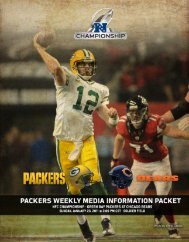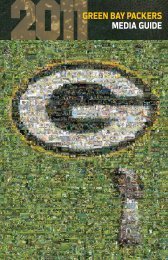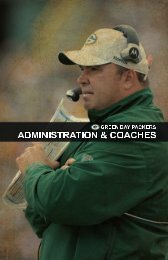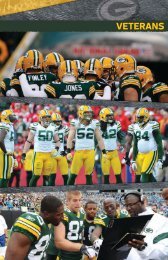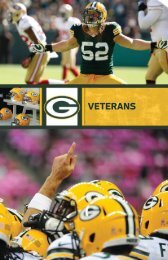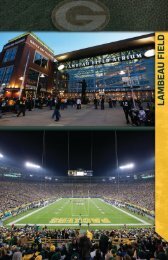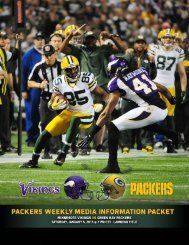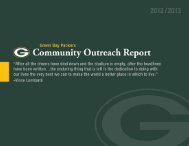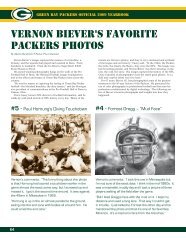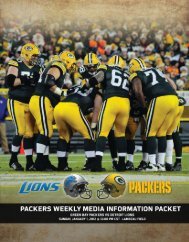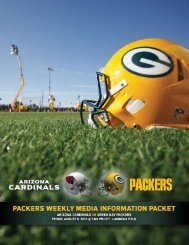THE PACKERS STORYCOMMUNITYADMIN. &COACHESVETERANSDRAFT &FREE AGENTS2012 REVIEWPACKERSSTORYLAMBEAUFIELDMISC.1995 Packers put together one of the hallmark seasons in theirhistory. Winning six of their last seven games, they captured theirfirst NFC Central Division crown since 1972, then made their bestpostseason showing in more than 28 years, forging all the way to theNFC Championship Game.En route, they closed the regular season 11-5 – their best marksince the 1966 <strong>NFL</strong> championship club (12-2) – and followedby dispatching the Falcons, 37-20, in a first-round playoff atLambeau Field. Building on that win, the Packers mounted one of thepremier performances in their postseason history, formally dethroningthe defending Super Bowl champion San Francisco 49ers in their ownstadium, 3Com Park, 27-17. Again, however, dreams of a Super Bowlfloundered in Dallas, 38-27, in the NFC title game, after the Packersled 27-24 at the end of three quarters.Putting nearly three decades of disappointment emphaticallybehind, the Packers rewarded their long-patient faithful in 1996.Shunting aside eight of their first nine foes, they swept to a 13-3record and their second straight division championship. Then, theycaptured their first <strong>NFL</strong> title since 1967, dispatching New England,35-21, in Super Bowl XXXI at the Louisiana Superdome.Displaying impressive consistency on both sides of the ball, theydocumented their superiority, outscoring three opponents 100-48 in apostseason sweep. Appropriately, the first two wins were before theirLambeau loyalists – a 35-14 divisional triumph over the 49ers and a30-13 win over the upstart Carolina Panthers in the NFC title game.In winning a 12th <strong>NFL</strong> championship, extending their own leaguerecord, the Packers joined an elite group of teams with three ormore Super Bowls (Dallas, San Francisco, Pittsburgh, Oakland andWashington).The Packers thus entered 1997 with an opportunity to win backto-backSuper Bowls for a second time – and came breathtakinglyclose to achieving their objective. Sweeping to a second consecutive13-3 mark, tying a club record with 13 wins, they primed for theplayoffs by ending the season with five straight wins. After a thirdconsecutive division title, they launched their bid at Lambeau Fieldin workmanlike fashion, turning back Tampa Bay in the divisionalplayoff, 21-7. The win padded their all-time home-field postseasonrecord to 12-0, extending the longest such winning streak in profootball history.Forced to win on the road for a return to the ultimate game, thePackers smothered the 49ers on a soggy, rain-swept afternoon in SanFrancisco, 23-10. Garnering a berth in the Super Bowl, Green Bay heldthe Niners without an offensive touchdown.In a see-saw affair, Super Bowl XXXII in San Diego found thePackers trailing Denver at halftime, 17-14. Hopes of a repeat werehigh, however, when quarterback Brett Favre engineered an 85-yarddrive, knotting the contest, 24-24, early in the fourth quarter. Butthe Broncos later scored with only 1:45 remaining and a last-minutePackers drive fell short when Favre’s pass for tight end Mark Chmurafell in<strong>com</strong>plete inside the Denver 20, with only 28 seconds left, sealingthe Broncos’ 31-24 win.A third straight Super Bowl trip, a realistic goal at the outset,eluded the Packers in 1998, their 80th season. Historic ac<strong>com</strong>plishment,however, did not, as they advanced to the playoffs for the sixthyear in a row, a team record, while posting a seventh consecutivewinning season. Green Bay overcame multiple injuries, includingthe loss of Pro Bowl running back Dorsey Levens (out nine games)and center Frank Winters (stretch run and postseason), each with abroken leg. They set another team record by stretching their LambeauField winning streak to 25 games – the second longest in <strong>NFL</strong> history– before falling to the Minnesota Vikings Oct. 5. They finished 11-5,equaling another team standard by posting a double-digit victorytotal for the fourth consecutive year (11-5 in 1995, 13-3 in both 1996and 1997). The only other time Green Bay had strung together fourseasons of 10-plus wins was 67 years earlier – Lambeau’s triple <strong>NFL</strong>champions of 1929-32 (12-0-1 in 1929, 10-3-1 in 1930, 12-2 in 1931and 10-3-1 in 1932).In the wake of these considerable achievements, the Packers’510season came to a dramaticand painful end in an NFCWild Card game at SanFrancisco, when a 27-23lead abruptly dissolved intoa 30-27 49ers victory. SteveYoung’s 25-yard touchdownpass to Terrell Owenssealed the game with justthree seconds left.Only five days later,Holmgren resigned tobe<strong>com</strong>e head coachand director of footballoperations for the SeattleSeahawks.ROUGH RHODE(S)Moving swiftly, Wolf tabbed Ray Rhodes, former Eagles headcoach and Green Bay defensive coordinator, as the Packers’ 12th headcoach, Jan. 11, 1999. The Packers launched 1999 under Rhodes inbreathtaking fashion, winning three of the first four games in the lastminute. Fate, however, suddenly stopped smiling as Green Bay (8-8)missed the playoffs for the first time since 1992, ending seven straightwinning seasons. Saying the Packers lacked the needed toughnessand fire, Wolf relieved Rhodes soon after the season finale.THE SHERMAN TENUREAfter searching more than two weeks, Wolf surprised many <strong>NFL</strong>observers by naming Mike Sherman as the Packers’ 13th head coach,Jan. 18, 2000. Sherman in 2000 surmounted multiple injuries, includingFavre’s prolonged bout with elbow tendinitis, and finished 9-7,inches from the playoffs.One month after a stirring finish – a four-game winning streak– Wolf retired as the team’s executive vice president and general manager,Feb. 1, 2001, and President Bob Harlan quickly named Shermanto replace Wolf. Sherman became the first head coach with the GMtitle since Starr in 1980.Wolf’s impressive nine-year tenure included 101 total victories(including eight in the playoffs) and the <strong>NFL</strong>’s best regular-seasonrecord (83-45) since the 1993 advent of free agency.Now with full authority over football, Sherman answered in 2001by returning the Packers to the playoffs, improving his winningpercentage to .656 (21-11), best ever over a Packers coach’s first twoyears. Behind Favre and explosive Ahman Green (1,981 yards fromscrimmage), the Packers went 12-4, but couldn’t grasp the divisiontitle, despite sweeping the division champion Bears. The Packersknocked off the Niners in a Wild Card playoff, but couldn’t get pasteventual NFC champion St. Louis.In 2002, Green Bay overcame an injury-plagued season to tie forthe league’s best record at 12-4. Despite injured starters missing 63<strong>com</strong>bined games, the Packers clinched their division, the inauguralNFC North title, on Dec. 1. Favre finished two votes shy of a fourthMVP, and defensively, behind Pro Bowler Darren Sharper, the teamranked third in the <strong>NFL</strong> against the pass and led the league with 45takeaways, six more than any other team. But Michael Vick and theFalcons became the first team ever to beat the Packers at home inthe playoffs.A return to the NFC Championship slipped painfully through thePackers’ fingers in 2003. Donovan McNabb led the Eagles to a <strong>com</strong>efrom-behind,20-17 overtime win to end an emotional Packers run inthe Divisional playoffs.The loss snapped a memorable five-game winning streak. Thestretch included changes to three of the most-revered records inPackers history (Gregg’s 33-year-old consecutive-games streak, brokenby Favre; Jim Taylor’s 41-year-old season rushing record, Green;and Don Hutson’s 58-year-old career scoring mark, Ryan Longwell).Green Bay captured an improbable division title in the last two minutesof the season, when Arizona upset Minnesota and the Lambeau Fieldcrowd broke the news to the Packers.Adding to the hallmark of Sherman’s tenure, the Packers overcamea 1-4 start in 2004, the club’s roughest since 1991, to finish 10-6and win a third straight division title. The 9-2 stretch run featuredfour wins on last-second field goals by Longwell, including a 34-31division-clinching win in Minnesota on Christmas Eve.However, just two weeks later the same Vikings avenged the losswith a 31-17 win in a Wild Card playoff at Lambeau Field.On Jan. 14, 2005, Harlan restructured the team’s football operations,naming Ted Thompson general manager, with full authorityover football decisions. Harlan said he based the decision on his beliefin a preferred structure – separate individuals for the GM and headcoachpositions.Only 37 minutes into the 2005 regular season, the Packers lost
leading receiver Javon Walker (knee). In the ensuing weeks, the teamalso lost starting halfback Green (quadricep) and several other keyoffensive performers, contributing to a 4-12 mark.Following the season on Jan. 2, saying it was time for a new faceto lead the team, Thompson dismissed Sherman.THE PRESENTThompson underwent a grueling nine-day search to tab MikeMcCarthy the franchise’s 14th head coach (Jan. 12, 2006).McCarthy guided the Packers to a resilient four-game winningstreak to close his first season as head coach with an 8-8 record,keeping the team in contention for the playoffs until the final weekendof 2006, when mere percentage points dubbed the Giants the NFC’slast postseason qualifier.McCarthy was disappointed the Packers just missed the playoffs,particularly because the team was as healthy as it had been all seasonand was playing its best football the last month. But the <strong>NFL</strong>’s youngestclub carried that momentum into 2007, winning its first four gamesand ultimately tying the franchise record for regular-season victorieswith a 13-3 mark. McCarthy also tied Sherman’s team mark for themost wins by a head coach in his first two seasons (21).With Joe Philbin taking over as offensive coordinator, Ryan Grantemerging at midseason as a feature back, and Favre enjoying a brilliantfinal season in Green Bay, the offense finished second in the league,its highest ranking since 1983.Grant then posted franchise playoff records of 201 rushing yardsand three touchdowns in a 42-20 snow-filled NFC playoff triumphover Seattle at Lambeau, but the club’s quest for a fifth Super Bowlappearance came up agonizingly short.In the third-coldest game in <strong>NFL</strong> championship history, with atemperature of minus-1 and wind chill of minus-23 at kickoff, GreenBay fell at home, 23-20, in overtime to the New York Giants in the NFCChampionship Game.In 2008, the torch was passed to Aaron Rodgers from Favre, whoretired in March with virtually every significant <strong>NFL</strong> passing record,un-retired in July and was traded to the New York Jets during the firstweek of training camp. Rodgers became just the second quarterbackin league history to pass for more than 4,000 yards in his first seasonas a starter, and the offense produced a 4,000-yard passer, 1,200-yardrusher (Grant) and two 1,000-yard receivers (Greg Jennings, DonaldDriver) for the first time in team history.On defense, the team set a franchise record with seven touchdowns,including six on interception returns, leading to Pro Bowlberths for three-fourths of the starting secondary in Nick Collins,Charles Woodson and Al Harris. But that wasn’t enough to over<strong>com</strong>einjuries and other short<strong>com</strong>ings on that side of the ball, and with theteam losing seven games by four points or less, the final 6-10 markwas just the franchise’s second losing season dating back to 1992.That led to a series of changes on the coaching staff, most of themon defense, as McCarthy hired Dom Capers as his new defensive coordinatorto institute a switch to a 3-4 scheme. The players respondedfaster than most predicted in 2009, climbing all the way to No. 2 inthe league in yards allowed and No. 1 against the run for the first timein team history, setting a franchise record for fewest rushing yardsallowed per game (83.3).That defensive prowess was highlighted by Woodson winning <strong>NFL</strong>Defensive Player of the Year, rookie Clay Matthews leading the teamin sacks, and Collins joining both as Pro Bowl honorees. Combinedwith another dynamic season on offense – as the quartet of Rodgers,Grant, Jennings and Driver repeated their feat of the prior year and anew franchise record for points (461) was established – the Packerswon seven of their final eight regular-season games to finish 11-5 andearn an NFC Wild Card playoff berth.511A UNIQUE FRANCHISE• No owner (last remaining publicly owned pro sports team,4,750,937 shares, 112,120 stockholders, none of whomreceive dividend on initial investment).• Team plays in major sports’ smallest TV market – 70th(New Orleans, 53, is closest).• Packers have 14 playoff appearances in last 19 years, andwon most <strong>NFL</strong> titles (13).• Green Bay has 21 Pro Hall of Famers, second most in league.• Team has averted four financial collapses: 1921, 1922,1934 and 1950, each time gaining monetary support from<strong>com</strong>munity.• In a century of franchise movement, only 10 other pro sportsteams – none in football – have held same moniker insame location longer (nine baseball, one hockey).• Only two other pro sports venues have been in continuoususe longer than Lambeau Field (1957) – Boston’s FenwayPark (1912) and Chicago’s Wrigley Field (1916).• With season-ticket holders from all 50 states, as well asWashington, D.C., Canada, Japan and Australia, the team’swaiting list has nearly 100,000 names on it. People who wererecently awarded season tickets put their names on the waitinglist in the mid-1970s.• Packers have most fans in league based on recent Harrispolls, merchandise sales and website attraction. Plus, theteam sells every available seat at Lambeau Field for intrasquadscrimmage, “Family Night.”• Before radio, when Packers played on the road, as many as500 fans turned out at Legion Park to “watch” game on Playographboard (telegraph reports from press box re-createdgame on screen, <strong>com</strong>plete with PA).• Packers were first to open hall of fame and museum (1967).Rodgers earned his first Pro Bowl nod and made a memorablepostseason debut, throwing for a Green Bay postseason-record 423yards and record-tying four TDs as he rallied the Packers from a21-point second-half deficit. Emerging tight end Jermichael Finleyalso set a team playoff mark with 159 yards receiving and tied a teampostseason record with nine receptions.Ultimately the Packers came up short, however, dropping a 51-45overtime heartbreaker in Arizona, the highest-scoring postseasongame in <strong>NFL</strong> history. But the disappointment fueled a determinationand the late-season surge sparked a genuine optimism heading into2010.That optimism led to high expectations, and the Packers becamea popular preseason pick to represent the NFC in the Super Bowl.Boasting both a deep and maturing roster, and relative scheme continuityon both sides of the ball, prognosticators felt confident GreenBay was primed for a deep playoff run.The team got out to a 3-1 start in the season’s first quarter, butinjuries to key players mounted, and that perceived roster strengthwould be put to the test. Grant, a back-to-back 1,200-yard rusher,was lost for the season in Week 1. Finley, the team’s leading receiverentering Week 5, was also placed on injured reserve, as was linebackerNick Barnett, the second all-time leading tackler in franchise history.By season’s end, the Packers would allocate 15 players to the seasonendinginjured list. In what was a true testament both to Thompson’sassembly of the roster and the coaching staff’s tireless <strong>com</strong>mitment togetting players ready to contribute, the Packers never blinked.Rodgers led the offense by throwing for nearly 4,000 yards andposting a quarterback rating of 101.2. Jennings picked up the slackin the absence of Finley, finishing with 1,265 yards and earning hisfirst selection to the Pro Bowl. Defensively, the Packers again thrivedunder Capers’ detailed instruction, ranking No. 2 in the <strong>NFL</strong> in scoringdefense at 15.0 points per game. Matthews proved that his rookiecampaign was no fluke and became a dominant pass rusher off theedge. Voted a Pro Bowl starter and consensus first-team All-Pro, hefinished with 13.5 sacks and was named the league’s Defensive Playerof the Year by various publications. In the secondary, Woodson followedup his stellar 2009 run with another solid season, setting careerhighs in tackles and forced fumbles and be<strong>com</strong>ing the team’s emotionalleader throughout. His counterpart at corner, Tramon Williams,emerged as a standout cover man and led the team with six interceptions,earning his first bid to the Pro Bowl, where he was joined byCollins, who was chosen for the third consecutive year.Despite the constant fluidity of the gameday lineup, the Packershung tough in all 16 games. Their six losses came by a <strong>com</strong>bined 20points, and they became the first team since the AFL-<strong>NFL</strong> merger in1970 to never trail a game by more than seven points over an entireseason. They finished the regular season with a 10-6 record followingCOMMUNITYTHE PACKERS STORYADMIN. &COACHESDRAFT &VETERANS FREE AGENTS 2012 REVIEWPACKERSSTORYLAMBEAUFIELD MISC.
- Page 1:
RECORDS& HISTORY
- Page 12 and 13:
INDIVIDUAL RECORDSCOMMUNITYADMIN. &
- Page 14 and 15:
INDIVIDUAL RECORDSCOMMUNITYADMIN. &
- Page 16 and 17:
INDIVIDUAL RECORDSCOMMUNITYADMIN. &
- Page 18 and 19:
INDIVIDUAL RECORDSCOMMUNITYADMIN. &
- Page 20 and 21:
TEAM RECORDSCOMMUNITYADMIN. &COACHE
- Page 22 and 23:
TEAM RECORDSCOMMUNITYADMIN. &COACHE
- Page 24 and 25:
TEAM RECORDSCOMMUNITYADMIN. &COACHE
- Page 26 and 27:
TEAM RECORDSCOMMUNITYADMIN. &COACHE
- Page 28 and 29:
TEAM RECORDSCOMMUNITYADMIN. &COACHE
- Page 30:
TEAM RECORDSCOMMUNITYADMIN. &COACHE
- Page 33:
Most Opponent Yards Lost Attempting
- Page 36 and 37:
THE LAST TIMECOMMUNITYADMIN. &COACH
- Page 38 and 39:
THE LAST TIMECOMMUNITYADMIN. &COACH
- Page 40 and 41:
YEARLY STATISTICAL LEADERSCOMMUNITY
- Page 42 and 43:
YEARLY STATISTICAL LEADERSCOMMUNITY
- Page 44 and 45:
YEARLY STATISTICAL LEADERSCOMMUNITY
- Page 46 and 47:
YEARLY STATISTICAL LEADERSCOMMUNITY
- Page 49:
AHMAN GREEN, 2003Date Opp Att Yds T
- Page 52 and 53:
OUTSTANDING PERFORMERSCOMMUNITYADMI
- Page 54 and 55:
OUTSTANDING PERFORMERSCOMMUNITYADMI
- Page 56 and 57:
ALL-TIME SCORING — INDIVIDUALCOMM
- Page 58 and 59:
ALL-TIME SCORING — INDIVIDUALCOMM
- Page 60 and 61:
RESULTS BY TEAMCOMMUNITYADMIN. &COA
- Page 62 and 63:
RESULTS BY TEAMCOMMUNITYADMIN. &COA
- Page 64 and 65:
RESULTS BY TEAMCOMMUNITYADMIN. &COA
- Page 66 and 67:
ALL-TIME RESULTS BY SEASONCOMMUNITY
- Page 68:
ALL-TIME RESULTS BY SEASONCOMMUNITY
- Page 71 and 72:
Head Coach: Earl “Curly” Lambea
- Page 73 and 74:
8-2-0, .800, FIRST, WESTERN DIVISIO
- Page 75 and 76:
6-5-0, .545, THIRD (TIE), WESTERN D
- Page 77 and 78:
3-9-0, .250, FOURTH, WESTERN DIVISI
- Page 79 and 80:
3-9-0, .250, FIFTH (TIE), NATIONAL
- Page 81 and 82:
6-6-0, .500, FOURTH, NATIONAL CONFE
- Page 83 and 84:
GB OppTotal First Downs . . . . .20
- Page 85 and 86:
4-8-0, .333, FIFTH (TIE), WESTERN C
- Page 87 and 88:
GB OppTotal First Downs . . . . .17
- Page 89 and 90:
GB OppTotal First Downs . . . . .23
- Page 91 and 92:
13-1-0, .929, FIRST, WESTERN CONFER
- Page 93 and 94:
8-5-1, .615, SECOND (TIE), WESTERN
- Page 95 and 96:
12-2-0, .857, FIRST, WESTERN CONFER
- Page 97 and 98:
6-7-1, .462, THIRD, NFL CENTRAL 196
- Page 99 and 100:
6-8-0, .429, THIRD, NFC CENTRAL 197
- Page 101 and 102:
10-4-0, .714, FIRST, NFC CENTRAL 19
- Page 103 and 104:
6-8-0, .429, THIRD, NFC CENTRAL 197
- Page 105 and 106:
5-9-0, .357, FOURTH, NFC CENTRAL 19
- Page 107 and 108:
8-7-1, .531, SECOND, NFC CENTRAL 19
- Page 109 and 110:
GB OppTotal First Downs . . . . .30
- Page 111 and 112:
5-3-1, .611, THIRD, NFC 1982Head Co
- Page 113 and 114:
8-8-0, .500, SECOND, NFC CENTRAL 19
- Page 115 and 116:
4-12-0, .250, FOURTH, NFC CENTRAL 1
- Page 117 and 118:
Head Coach: Lindy Infante GB Opp At
- Page 119 and 120:
6-10-0, .375, FOURTH, NFC CENTRAL 1
- Page 121 and 122:
9-7-0, .563, SECOND, NFC CENTRAL 19
- Page 123 and 124:
9-7-0, .563, SECOND, NFC CENTRAL 19
- Page 125 and 126:
13-3-0, .813, FIRST, NFC CENTRAL 19
- Page 127 and 128:
11-5-0, .688, SECOND, NFC CENTRAL 1
- Page 129 and 130:
9-7-0, .563, THIRD, NFC CENTRAL 200
- Page 131 and 132:
12-4-0, .750, FIRST, NFC NORTH 2002
- Page 133 and 134:
10-6-0, .625, FIRST, NFC NORTH 2004
- Page 135 and 136:
8-8-0, .500, SECOND, NFC NORTH 2006
- Page 137 and 138:
6-10-0, .375, THIRD, NFC NORTH 2008
- Page 139 and 140:
10-6-0, .625, SECOND, NFC NORTH 201
- Page 141 and 142:
11-5-0, .688, FIRST, NFC NORTH 2012
- Page 143 and 144: OVERALLHOME GREEN BAY MILWAUKEEYear
- Page 145 and 146: GREEN BAY 35, KANSAS CITY 10Los Ang
- Page 147 and 148: GREEN BAY 35, NEW ENGLAND 21Louisia
- Page 149 and 150: DENVER 31, GREEN BAY 24Qualcomm Sta
- Page 151 and 152: GREEN BAY 31, PITTSBURGH 25Cowboys
- Page 153 and 154: First played January 15, 1967, at t
- Page 155 and 156: GREEN BAY’S 48 POSTSEASON GAMESOv
- Page 157 and 158: PACKERS 37, N.Y. GIANTS 01961 NFL C
- Page 159 and 160: DALLAS 37, PACKERS 261982 NFC Secon
- Page 161 and 162: 1996 NFC Divisional Playoff, contin
- Page 163 and 164: Favre lobbied with coaches at halft
- Page 165 and 166: PACKERS 42, SEATTLE 202007 NFC Divi
- Page 167 and 168: overs and a leaky pass defense that
- Page 169 and 170: RECEIVINGMost Receptions, Career50
- Page 171 and 172: Most Punt Return Yards, Career214 R
- Page 173 and 174: PUNT RETURNSMost Punt Returns, Game
- Page 175 and 176: PACKERS IN THE PRO FOOTBALL HALL OF
- Page 177 and 178: 1977 — FORREST GREGGTackle (1956,
- Page 179 and 180: INDUCTED FALL 1970Bernard “Boob
- Page 181 and 182: 1960 — LB Bill Forester (AP, UPI,
- Page 183 and 184: 1938 — FB Clarke Hinkle, QB Cecil
- Page 185 and 186: Date Opponent W/L ScoreN25, 1920 St
- Page 187 and 188: (Continued from previous page)ALL-T
- Page 189 and 190: 1985 (1-3-0)GB Opp AttendA 10 @ Dal
- Page 191 and 192: On Aug. 11, 1919, a score or more h
- Page 193: BENGTSON PERIODFollowing the third
- Page 197 and 198: 1919• Packers founded at meetings
- Page 199 and 200: PACKERS PATENTSFootball historians
- Page 201 and 202: • First annual Green Bay Packers
- Page 203 and 204: Somewhat by chance, CurlyLambeau an
- Page 205 and 206: More thanfour decades afterhis deat
- Page 207 and 208: SHAREHOLDER HISTORY & FINANCIAL HIS
- Page 209 and 210: GREEN BAY’S 14 HEAD COACHESHEAD C
- Page 211 and 212: McCarthy, Mike Quarterbacks . . . .
- Page 213 and 214: Brown, Dave (CB), Michigan . . . .
- Page 215 and 216: Giordano, Matt (S), California . .
- Page 217 and 218: Laws, Joe (B), Iowa. . . . . . . .
- Page 219 and 220: Prokop, Joe (P), Cal Poly-Pomona .
- Page 221 and 222: Walker, Val Joe (DB), Southern Meth
- Page 223 and 224: Hasselbeck, Matt (QB), Boston Colle
- Page 225 and 226: Jenkins, Billy (S), Howard . . . .
- Page 227 and 228: Sampson, Howard (DB), Arkansas . .
- Page 229 and 230: Arthur, Mike (C), Texas A&M . . . .
- Page 232 and 233: ALL-TIME UNIFORM NUMBERSCOMMUNITYAD
- Page 234 and 235: ALL-TIME UNIFORM NUMBERSCOMMUNITYAD
- Page 236 and 237: UNIFORM HISTORYCOMMUNITYADMIN. &COA
- Page 238 and 239: PACKERS TRADESCOMMUNITYADMIN. &COAC
- Page 240 and 241: PACKERS TRADESCOMMUNITYADMIN. &COAC
- Page 242 and 243: ALL-TIME PACKERS DRAFTSCOMMUNITYADM
- Page 244 and 245:
ALL-TIME PACKERS DRAFTSCOMMUNITYADM
- Page 246 and 247:
ALL-TIME PACKERS DRAFTSCOMMUNITYADM
- Page 248 and 249:
ALL-TIME PACKERS DRAFTSCOMMUNITYADM
- Page 250 and 251:
ALL-TIME PACKERS DRAFTSCOMMUNITYADM
- Page 252 and 253:
ALL-TIME PACKERS DRAFTSCOMMUNITYADM
- Page 254 and 255:
ALL-TIME PACKERS DRAFTSCOMMUNITYADM
- Page 256 and 257:
FREE AGENCYCOMMUNITYADMIN. &COACHES
- Page 258:
PRACTICE SQUADCOMMUNITYADMIN. &COAC



